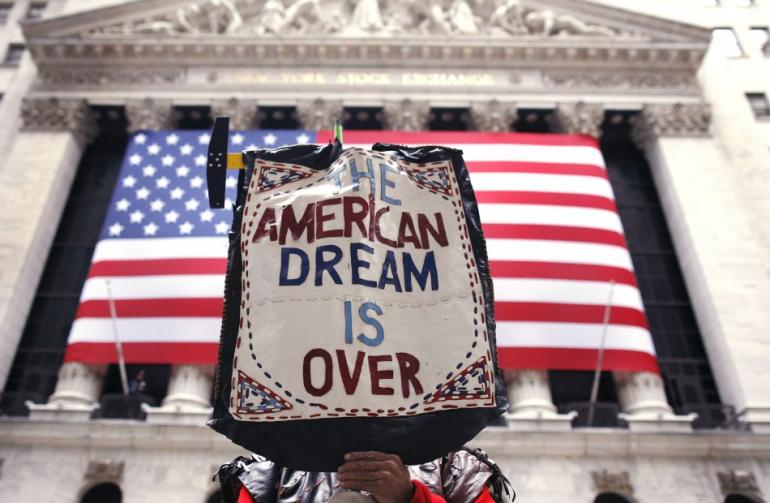American Decline
Our parents were sure that they were going to live better than their parents and that we, their children, were going to live better than them. We, alas, are growing quite concerned that we are not going to retire as well-off as our parents did, and our kids probably are not going to be as well-off as we are. (Freidman, 301)
America is no longer the world’s greatest country. America has fallen from its top spot and we must accept this harsh truth in order to reverse the decline of our country. We will pass down a country riddled with problems to our children and leave them struggle from the beginning. America is no longer the world’s greatest country.
We’re seventh in literacy, twenty-seventh in math, twenty-second in science, forty-ninth in life expectancy, 178th in infant mortality, third in median household income, number four in labor force, and number four in exports. We lead the world in only three categories: number of incarcerated citizens per capita, number of adults who believe angels are real, and defense spending, where we spend more than the next twenty-six countries combined, twenty-five of whom are allies.
“It (America) sure used to be (the best country). We stood up for what was right. We fought for moral reasons. We passed laws, struck down laws – for moral reasons. We waged wars on poverty, not on poor people. We sacrificed, we cared about our neighbors, we put our money where our mouths were and we never beat our chest. We built great, big things, made ungodly technological advances, explored the universe, cured diseases and we cultivated the world’s greatest artists and the world’s greatest economy. We reached for the stars, acted like men. We aspired to intelligence, we didn’t belittle it. It didn’t make us feel inferior. We didn’t identify ourselves by who we voted for in the last election and we didn’t scare so easy. We were able to be all these things and do all these things because we were informed… by great men, men who were revered. First step in solving any problem is recognizing there is one. America is not the greatest country in the world anymore.” (Sorkin)
The World is rapidly changing; new world powers, like China and India, are rising and America is unequipped to combat its new competitors. In the past few years and even decades, America’s standards and global rankings in education, health, economics, foreign affairs, inequality, violence, media effects, and politics have slowly slipped.
“The American future is going to be very different from its past. Our children and grandchildren will live in a world in which originality, creativity, and meticulous workmanship are prized. Thoughtless assembly-line tasks will be done by robots. People who adapt to new circumstances and tools will thrive. People who choose not to change may find life is more challenging.” (George, 2007)
Previously a leader in education, America has fallen hard in recent years. “While the U.S. spends more per student than most countries, this does not translate into better performance. For example, the Slovak Republic, which spends around USD 53,000 per student, performs at the same level as the United States, which spends over USD 115,000 per student” (Chappell, 2013). The Programme for International Student Assessment (PISA) is an international assessment administered every 3 years that tests 15 year-olds on reading, mathematics, and science. In mathematics, 29 nations outperformed the United States by a statistically significant margin and in science, 22 education systems scored above the U.S. average. (Chappell, 2013) The United States is also outranked in literacy, where America is ranked 24th out of 65 countries in literacy, according to PISA (Rice). However, the problem is that “other countries that were behind us, like Italy and Portugal, are now catching up. We are in a race in the global economy. The problem is not that we’re slowing down. The problem is that the other runners are getting faster” (Chappell, 2013). The United States is stuck in an educational rut whereas other countries, like Finland, are pioneering new educational techniques.
One issue is the quality of teachers. In many foreign countries, the teaching profession is well respected and requires more rigorous training to achieve a degree in education. In Finland, the globally ranked first in education in 2006, “professionals (are) selected from the top 10 percent of the nation’s graduates to earn a required master’s degree in education” (LynNell Hancock 1). While in America the bottom third of students are becoming teachers (D’Orio). In the United States “only 48 percent of eighth grade math teachers have a degree in math and over 90 percent of students in grades 5-9 are taught physical science by a teacher lacking major or certification in the area”(Wadhwa, 2007). This boils down to the fact that a majority of American teachers are not qualified to teach the subject they instruct. Finnish teachers also receive much higher respect, the teaching profession in Finland is equivalent to that of a doctor in the United States. Students are not only more hungry for knowledge in other countries, but their thirst for education inspires their teachers, creating a healthy symbiotic relationship. There is more incentive, along with heightened respect, to be a great teacher abroad. According to the most recent data available from the UNESCO Institute for Statistics, the top teacher salary for secondary teachers in the United States in 1999 was $48,037, making the U.S. rank tenth (Rice). The United States must find a way to inspire the best to be teachers.
Yet another problem with the American Education System is the student. “The average U.S. student spends about 900 hours in the classroom and 1,500 in front of the TV each year.” However, it is far more socially acceptable in America to spend hours practicing sports, rather than spending that same time studying. Clearly the priorities of a majority of American students are quite skewed, because while “the typical American student will spend 382,400 of these minutes in school, while the average Indian and Chinese student will devote 422,400 and 583,200 minutes to school, respectively” (Compton , Raney & Heeter). The World is becoming increasingly “flat.” This means that with the increasing availability of knowledge, due to the Internet, the gap between global knowledge is shrinking. Foreign nations have a hunger for learning, because education is, for the first time, widely available. However, “the things America is great at—higher education and entrepreneurial capacity and scientific and technical infrastructure—are very hard to replicate” (Porter & Rivkin, 2012). Because of this, nearly 60 percent of engineering PhD degrees awarded annually in the U.S. are earned by foreign nationals (Wadhwa, 2007). The flood of foreign college students is due to the drive of their education at younger ages. Of course America should welcome any foreigners, but we are not only losing the simple jobs to outsourcing, we are losing the jobs in need of higher education to our more motivated foreign counterparts. Jobs that use “basic computer coding, accounting, legal research, and financial analysis are migrating across the oceans… now that foreigners can do left-brain work cheaper, we in the U.S. must do right-brain work better” (Friedman 309). This means that America must train itself to be more creative and do the less routine jobs such as programming. In order for Americans to be more competitive globally, we must prepare our students for the creative jobs, some which may not even exist yet. As technology changes, American education must adapt to it, but the first step is inspiring out students to learn and our teachers to teach at their maximum ability.
According to the CIA’s world reports, the United States ranks 18th (33% of adults) in obesity in 2008 (The World Factbook). However, the most recent statistics from the Center for Disease Control (CDC) reported that 35.7% of adults and 17% of children are obese (“Obesity and overweight,” 2012). “The estimated annual medical cost of obesity in the U.S. was $147 billion in 2008 U.S. dollars; the medical costs for people who are obese were $1,429 higher than those of normal weight” (“Obesity and overweight,” 2012). but obesity doesn’t affect the price of health care alone. “The average obese person costs society more than $7,000 a year in lost productivity and added medical treatment, say researchers at George Washington University” (Freedman). We are raising our kids in a world full of nutritionally void foods. Convenience and price are the driving forces behind our food choices. As a majority American children are being brainwashed by fast food propaganda, so much so that most children can recognize a McDonald’s before they can speak (“Fast food facts,”). Some interesting facts about fast food in America:
-
In 1972, Americans spent $3 billion a year on fast food- today Americans spend more than $110 billion.
-
McDonald’s feeds more than 46 million people a day, that’s more than the entire population of Spain.
-
French fries are the most eaten vegetable (starch) in America ((“Fast food facts,”).
Obesity in a preventable and reversible disease. The Institute of Medicine has outlined simple steps to fixing the obesity epidemic.
-
Integrating physical activity into people’s daily lives
-
Making healthy food and beverage options available everywhere
-
Transforming marketing and messages about nutrition and activity
-
Making schools a gateway to healthy weights
-
Galvanizing employers and healthcare professionals to support healthy lifestyles (Gould, 2012).
America is quite egotistical. Yes, that is a harsh statement, but it is the truth. Americans are very proud and patriotism is definitely a thing to celebrate, According to DHL, a global leader in the logistics industry, the United States has a “depth of global connectedness” score of 18.18 (out of a possible score of 50) (Rice). That score makes the United States rank 89th out of 144.countries. In contrast, many Americans do not see this fatal flaw, because 79% of Americans have a “favorable view of America”(Rice). That percentage makes the United States the third highest ranking country (out of 23) in that category. While there is nothing wrong in believing in your own country, the percentages of other countries with favorable views was far lower than it could be. It is time America branches out to foreign countries and changes the way they view the United States. Most Americans are monolingual, whereas a majority of Europeans are multilingual. Americans rely on other countries to speak our language, and in an increasingly interconnected world that will only hinder the United States further. When asked about their opinions of American ideas and customs, not a single country’s population was over 70% favorable (“PewResearch Global Attitudes Project”). While it may seem superficial to worry over the outward image of America, it is a serious hindrance when trying to conduct business or engage in alliances, among many other things.
Perhaps the most shocking piece of information was when other countries were asked if they feel like they are partners with America. Only ten countries reported above 70% (the unit of percent measures the percentage of population that answered in favor of being partners with America) (“PewResearch Global Attitudes Project”). The worst part of this is that 9 of the 26 NATO members (not including the United States and Germany) reported scores less than 70%. The only NATO member to report a score above 70% was Germany, the remaining NATO members did not report scores for this category. There are many factors to why foreign countries do not like, or feel threatened by the United States. For example, we have the “big brother” effect on the world. In other words, America is an active protector of freedom as well as our partner countries throughout the world.
Raised as a military child I love America. I would not change my nationality for anything. It hurts to admit that America is not as great as I’ve always been told it was. But without acknowledging this, the current situation cannot be changed. America has come a long way, born from rebellion and raised on the values of freedom, America has truly paved the way for many countries. America will always be an example for other nations. It is only “halftime in America.” Cities like Detroit are undergoing facelifts and making comebacks. First Lady Michelle Obama has lowered the childhood obesity rate for the first time in thirty years through her Let’s Move campaign. There is no doubt America can be great again. We must end half time. Let the second half begin.
Works Cited
LynNell Hancock, . “Why Are Finland’s Schools So Successful?.” Smithsonian.com. Sept. 2001: 1. Web. 9 Apr. 2014. http://www.smithsonianmag.com/innovation/why-are-finlands-schools-successful-49859555/#8hW6EX6G3FoAWsUC.99
Sorkin , A. (n.d.). The newsroom speech – best opening scene for a series?. Retrieved from http://www.esotericarticles.com/the-newsroom-speech-best-opening-scene-for-a-series.html
Gould, D. (2012, May 12). A systems approach to solving america’s obesity problem. Retrieved from http://www.forbes.com/sites/daniellegould/2012/05/11/a-systems-approach-to-solving-americas-obesity-problem/
Fast food facts from the super size me website. (n.d.). Retrieved from http://www.vivavegie.org/101book/text/nolink/social/supersizeme.htm
Obesity and overweight facts. (2012, April 27). Retrieved from http://www.cdc.gov/obesity/data/facts.html
George , P. (2007). Building a better america: Educating our children for a complex future. Retrieved from http://www.libertyforall.net/building-a-better-america-educating-our-children-for-a-complex-future/
Chappell, B. (2013, Dec 03). U.s. students slide in global ranking on math, reading, science. Retrieved from http://www.npr.org/blogs/thetwo-way/2013/12/03/248329823/u-s-high-school-students-slide-in-math-reading-science
D’Orio, W. (n.d.). Finland is #1!
Rice, M. (n.d.). Ranking america: A site for information about the u.s.. Retrieved from http://rankingamerica.wordpress.com/
Wadhwa, V. (2007). 2 million minutes: The facts. Retrieved from http://www.2mminutes.com/reference.asp
Compton , R., Raney, A., & Heeter, C. (n.d.). 2 million minutes: A global examination. Retrieved from http://hepg.org/her/booknote/338
Porter, M., & Rivkin, J. (2012, Nov 21). United states: What washington must do now. The Economist. Retrieved from http://www.economist.com/news/21566352-michael-porter-and-jan-rivkin-co-leaders-harvard-business-schools-united-states-competitiveness
Freedman, D. How to fix the obesity crisis. Scientific American. Retrieved from http://www.scientificamerican.com/article/how-to-fix-the-obesity-crisis/
Friedman, T. L. (). The Right Stuff: Tubas and Test Tubes. The world is flat.
The World Factbook. (n.d.). Central Intelligence Agency. Retrieved March 4, 2013, from https://www.cia.gov/library/publications/the-world-factbook/
“Opinion of Americans.” PewResearch Global Attitudes Project (2013): n.pag. PewResearch Global Indicators Database. Web. 2 Apr 2014. <http://www.pewglobal.org/database/indicator/2/ >.












